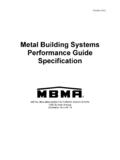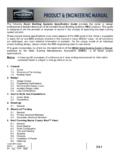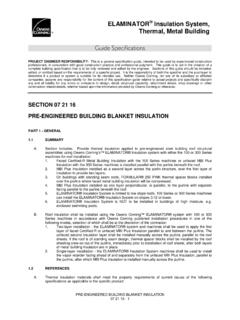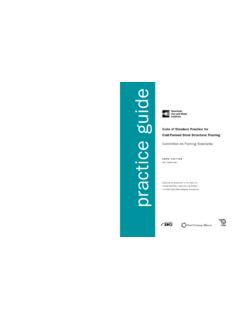Transcription of MBMA Seismic Design Guide for Metal Building Systems
1 MBMA Seismic Design Guide for Metal Building Systems 2000 IBC Edition R. E. Bachman1 and W. L. Shoemaker2. Abstract The Metal Building manufacturers association (MBMA) has sponsored the development of a comprehensive manual for the practical Seismic Design of Metal Building Systems . The manual, entitled the Seismic Design Guide for Metal Building Systems , provides Design approaches and procedures that are intended to be compliant with the Seismic requirements of the 2000 International Building Code (IBC). The Guide , which is expected to be published and available in the second quarter of 2004, uses an example problem format and thereby provides interpretations about common Design and analysis situations, which are common to Metal buildings. Guideline Style and Organization MBMA has sponsored the development of a comprehensive manual for the practical Seismic Design of Metal Building Systems .
2 The manual, entitled the Seismic Design Guide for Metal Building Systems , provides Design approaches and procedures that are intended to be compliant with the Seismic requirements of the 2000 International Building Code. The Guide is expected to be published and available in the second quarter of 2004. There are two primary parts to the Guide . In the relatively brief narrative first part of the Guide , the background and organization are described. Also the technical basis is discussed and the approach used to establish a consensus on judgment issues is presented. In the more lengthy second part of this Guide , four Design example problems are provided. The problems are in narrative form and are intended to illustrate acceptable approaches to deal with the most common Seismic Design issues encountered in the Design of Metal Building Systems .
3 The problems were defined by the MBMA Seismic Design Guide Steering Committee with the desire for them to represent realistic Design examples of Metal Building Systems . Throughout the Design examples, commentary is provided as italicized notes, as shown in this sentence. The comments are intended to provide the reader with discussion, which gives insights, background and perhaps potential future changes on the specific Seismic requirements that are being utilized at that point in the Design example. The four Design examples that are provided in the second part are: 1. Principal, Robert. E. Bachman Consulting Structural Engineer, Sacramento, California 2. Director of Research & Engineering, Metal Building manufacturers association , Cleveland, Ohio 1. Design Example 1 - Determination of Seismic Design Forces. The Seismic base shear forces are determined for a range of site locations and Metal Building system moment frame boundary conditions.
4 Design Example 2 - Design of Frames, Columns, Bracing and other Elements of the Lateral Force Resisting System. The example specifically considers the Design of end plate bolted moment frame connections. Design Example 3 - Determination of Seismic Design Forces and their distribution when a Metal Building contains a mezzanine with a concrete deck (rigid diaphragm). Design Example 4 - Determination of Seismic Design Forces and detailing associated with a Metal Building with hard walls (masonry or tilt-up). MBMA Seismic Guide Steering Committee Direction and Review The Metal Building manufacturers association (MBMA) commissioned the preparation of this document with the goal of providing a comprehensive manual for achieving practical Metal Building Design Systems that satisfy the 2000 IBC. To steer the development of the Guide , a steering committee was formed consisting of the following individuals: Buddy Oldner Ruffin Building Systems James R.
5 Miller Miller & Associates Mike Pacey Butler Research Scott Russell Nucor Building Systems Don Tobler Steelox Building Systems Steven J. Thomas VP Buildings Dennis P. Watson Star Building Systems W. Lee Shoemaker of MBMA was advisor to the Committee and acted as the primary liaison between the committee and the consultants who were engaged to prepare the Guide . The Steering Committee was involved in many ways on this project. They first defined the subjects that they wanted covered in the Guide . Secondly, they defined how they wanted the Guide to be organized ( Design examples). Thirdly, they provided the problem definitions for each of the Design examples. Fourthly, they provided analysis support so that where needed, analysis results reflect actual industry analysis practice. And finally they provided a comprehensive review of this document so that it represented at least a majority view of the Committee.
6 While full consensus was mostly achieved, in 2. some instances there was strong minority opinion on some issues or assumptions. These views are reflected in the document. Guideline Authors The Seismic Design Guide was authored by the following individuals: Robert Bachman, Principal, Bachman Consulting Structural Engineer Rick Drake, Principal Structural Engineer, Dyer &. Associates Martin Johnson, Project Manager, ABS Consulting Thomas M. Murray, Professor, Virginia Polytechnic Institute , and State University Each of these individuals provided special expertise to the Guide document. Mr. Bachman provided expertise in IBC Seismic Requirements and served as the lead guideline author for coordinating the Guide 's development among the Guide 's authors. Mr. Drake provided expertise on the AISC Seismic Provisions and served as the publication consultant.
7 Mr. Johnson provided expertise on Seismic Design issues associated with Metal buildings. Dr. Murray provided expertise on the Seismic Design of beam column moment connections. Codes and Standards Used as the Technical Basis for the Guidelines The Design basis of this Guide is the 2000 International Building Code (IBC), the American Institute of Steel Construction (AISC) Seismic Provisions for Steel Buildings, April 15, 1997, including Supplement No. 1, February 15, 1999, and common industry practice. This Guide focuses on Allowable Stress Design but points out differences and/or advantages of Load and Resistance Factor Design (LRFD) when appropriate. Where appropriate, revisions that have been accepted by ASCE 7-02 and AISC Seismic Provisions, Supplement No. 2, November 10, 2000, that have been incorporated into the IBC 2003 are discussed regarding the effect they will have on Seismic Design .
8 Basic Concept of Seismic Code Reduced Forces The 2000 IBC requires that all structures in most parts of the United States be designed to resist Design earthquake ground motions. As currently defined, these Design earthquake 3. motions have average return periods of between 300 and 800 years and are quite severe. If the forces resulting from these motions were designed to be resisted elastically by the structure (like what is done for wind loads), the resulting designs would be impractical for most Building in the higher Seismic regions of the United States. To provide a practical way to accommodate these motions, the practice of earthquake engineering has evolved to permit the elastic forces associated with severe earthquake ground motions to be reduced to Design earthquake force levels. This reduction has been based on observed performance of certain types of structures to inelastically absorb earthquake motions without collapse.
9 The codes have recognized this inherent performance with Seismic force reduction factors R . The more inelastic absorption capacity, the larger the value of R and the lower the Design earthquake forces. However, the larger the value the more detailing requirements are imposed on the Design to assure that the structure will perform inelastically as intended. Also, with larger values of R, more restrictions are imposed on proportioning of members and their limitations on the types of Systems that can have high R values. In higher Seismic areas, many structural Systems that have low R values are not permitted because they have low earthquake resistance reliability. It should be noted that the reduction of Seismic forces by R is a function of period. At periods less than one fifth of velocity transition period, the ground motion acceleration reduces proportionately to the period while the base shear force remains constant.
10 In the guideline document, Seismic force reduction factors are used which are consistent with the structural Systems found in Metal buildings. Because reduced forces are used, special Design and detailing is required for some members and connections. The Design examples illustrate where these special connection forces are required and how they should be applied. The user is cautioned that application of reduced Seismic forces in Design without the corresponding application of Seismic detailing will likely result in a Design that is not in compliance with the 2000 IBC. Metal Building Standard Design and Analysis Practice/Economy The Metal Building industry is very unique. The primary cornerstone of the Metal Building Design is to minimize Building cost through optimization of steel weight and the fabrication process.










